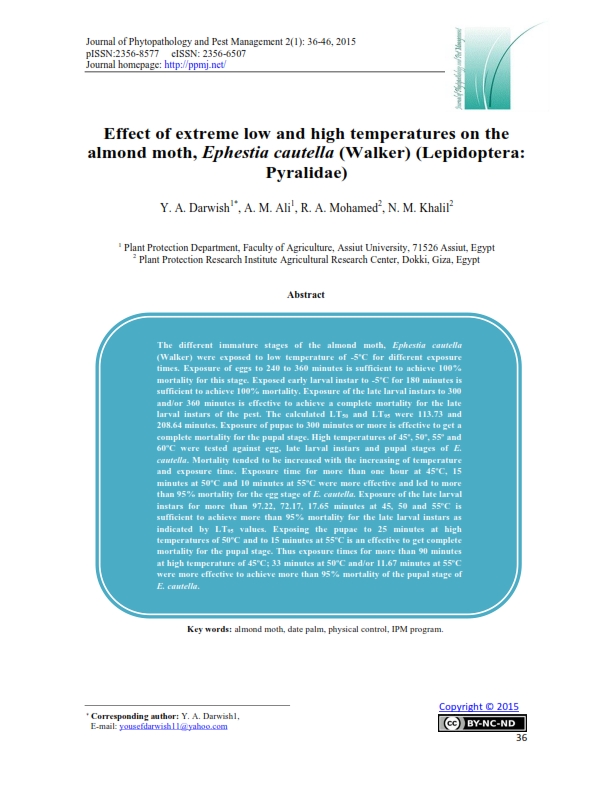Effect of extreme low and high temperatures on the almond moth, Ephestia cautella (Walker) (Lepidoptera: Pyralidae)
Keywords:
Almond moth, date palm, physical control, IPM program.Abstract
he different immature stages of the almond moth, Ephestia cautella (Walker) were exposed to low temperature of -5ºC for different exposure times. Exposure of eggs to 240 to 360 minutes is sufficient to achieve 100% mortality for this stage. Exposed early larval instar to -5ºC for 180 minutes is sufficient to achieve 100% mortality. Exposure of the late larval instars to 300 and/or 360 minutes is effective to achieve a complete mortality for the late larval instars of the pest. The calculated LT50 and LT95 were 113.73 and 208.64 minutes. Exposure of pupae to 300 minutes or more is effective to get a complete mortality for the pupal stage. High temperatures of 45º, 50º, 55º and 60ºC were tested against egg, late larval instars and pupal stages of E. cautella. Mortality tended to be increased with the increasing of temperature and exposure time. Exposure time for more than one hour at 45ºC, 15 minutes at 50ºC and 10 minutes at 55ºC were more effective and led to more than 95% mortality for the egg stage of E. cautella. Exposure of the late larval instars for more than 97.22, 72.17, 17.65 minutes at 45, 50 and 55ºC is sufficient to achieve more than 95% mortality for the late larval instars as indicated by LT95 values. Exposing the pupae to 25 minutes at high temperatures of 50ºC and to 15 minutes at 55ºC is an effective to get complete mortality for the pupal stage. Thus exposure times for more than 90 minutes at high temperature of 45ºC; 33 minutes at 50ºC and/or 11.67 minutes at 55ºC were more effective to achieve more than 95% mortality of the pupal stage of E. cautella.Â
Metrics

Published
How to Cite
Issue
Section
License
Authors who publish with Journal of Phytopathology and Disease Management agree to the following terms:
- Authors retain copyright and grant the journal right of first publication with the work simultaneously licensed under a Creative Commons Attribution License that allows others to share the work with an acknowledgement of the work's authorship and initial publication in this journal.
- Authors retain copyright and grant the journal right of first publication with the work simultaneously licensed under the Creative Commons Attribution-Non Commercial License (CC BY-NC). This allows others to share the work with an acknowledgement of the work's authorship and initial publication in this journal.
- Archives of Agricultural Sciences Journal is an Open Access Journal, and articles published are distributed under the terms of the Creative Commons Attribution-Non Commercial License (CC BY-NC). Readers may copy, distribute, and display the work for non commercial purposes with the proper citation of the original work. However, the journal retains the right to exploit subsidiary rights on behalf of the authors.
- Authors are able to enter into separate, additional contractural arrangements for the non-exclusive distribution of the journal's published version of the work (e.g. post it to an institutional repository or publish it in a book), with an acknowledgement of its initial publication in this journal.
- Authors are permitted and encouraged to post their work online (e.g., in institutional repositories or on their website) prior to and during the submission process with full disclosure to the journal, as it can lead to productive exchanges, as well as earlier and greater citation of published work. Following publication in Archives of Agricultural Sciences Journal, the author should update the repository, and include a citation and link to the published work.
Click here for more information on Licensing policy
.png)




